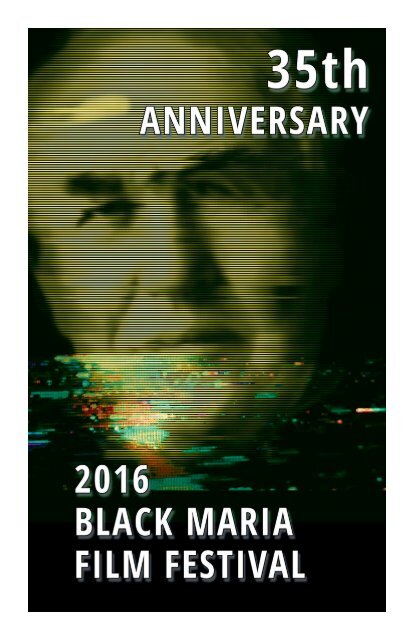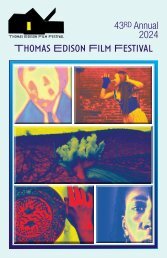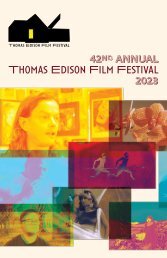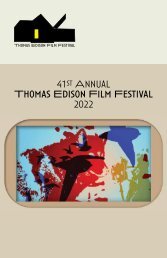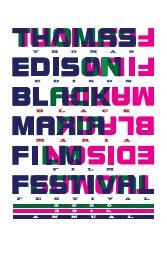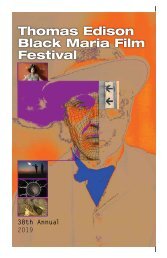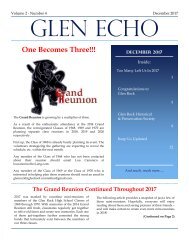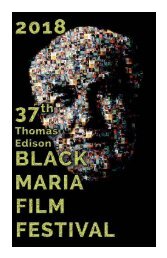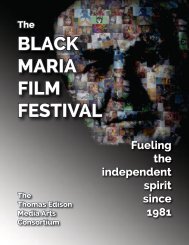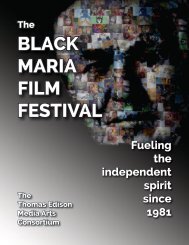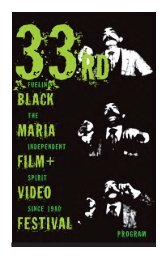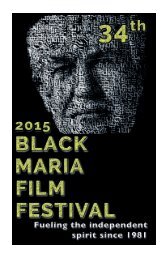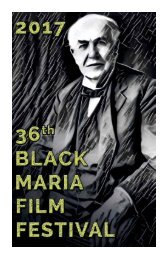2016 Black Maria Film Festival Program
Create successful ePaper yourself
Turn your PDF publications into a flip-book with our unique Google optimized e-Paper software.
2
FUELING THE<br />
INDEPENDENT<br />
SPIRIT FUELING<br />
THE 35 th ANNUAL<br />
BLACK MARIA<br />
FILM FESTIVAL<br />
THE INDEPENDENT<br />
SPIRIT FUELING<br />
THE INDEPENDENT<br />
SPIRIT FUELING<br />
THE INDEPENDENT<br />
SPIRIT FUELING<br />
THE INDEPENDENT<br />
SPIRIT FUELING<br />
THE INDEPENDENT<br />
This program is copyright © <strong>2016</strong>, The Thomas A. Edison<br />
Media Arts Consortium, Inc.<br />
SPIRIT<br />
<strong>2016</strong><br />
3
4
The <strong>Black</strong> <strong>Maria</strong><br />
<strong>Film</strong> <strong>Festival</strong><br />
tour is made possible<br />
in part by:<br />
New Jersey City University<br />
New Jersey State Council on the Arts<br />
Hudson County Office of Cultural and Heritage<br />
Affairs<br />
Microsoft Corporation*<br />
Adobe Systems, Inc.<br />
TechSoup Global<br />
Individual Donations<br />
* “Microsoft is pleased to support Thomas A. Edison Media Arts<br />
Consortium, Inc.”<br />
The <strong>Black</strong> <strong>Maria</strong> <strong>Film</strong> <strong>Festival</strong> is a project of the Thomas A. Edison<br />
Media Arts Consortium, an independent non-profit organization<br />
based at New Jersey City University. The festival was launched in<br />
1981 with the endorsement of the Thomas Edison National Historical<br />
Park in West Orange, NJ.<br />
To become a sponsor of the <strong>Black</strong> <strong>Maria</strong> <strong>Film</strong> <strong>Festival</strong>, please contact<br />
the consortium’s office or make a donation via the festival website:<br />
www.blackmariafilmfestival.org.<br />
Thomas A. Edison Media Arts Consortium<br />
<strong>Black</strong> <strong>Maria</strong> <strong>Film</strong> <strong>Festival</strong><br />
c/o Department of Media Arts – Fries Hall<br />
NJ City University<br />
2039 Kennedy Blvd., Jersey City, NJ 07305<br />
201.200.2043<br />
info@blackmariafilmfestival.org<br />
5
6
Contents<br />
From the Executive Director.........................................................9<br />
Jane Steuerwald<br />
A <strong>Festival</strong> for the People.................................................................13<br />
An Essay by Margaret Parsons, National Gallery of Art<br />
Napoleon, the Road Show............................................................23<br />
An Essay by Chapin Cutler, Boston Light & Sound<br />
How to Support the <strong>Festival</strong>........................................................33<br />
Jury’s Stellar Awards.......................................................................34<br />
Global Insights Stellar Awards..................................................... 37<br />
Jury’s Choice Awards...................................................................... 41<br />
Jury’s Citation Awards................................................................... 46<br />
Director’s Choice Awards..............................................................51<br />
Call for Entries: The <strong>Black</strong> <strong>Maria</strong> <strong>Film</strong> <strong>Festival</strong>......................68<br />
7
8<br />
The <strong>Black</strong> <strong>Maria</strong> <strong>Film</strong> <strong>Festival</strong> is grateful to the<br />
following individuals for their generous financial<br />
support<br />
Bonnie and John Anderson<br />
Tony Buba and Janice McMannis • Jon Cole<br />
Mary-Jo and Michael Dervos • Don Drelich<br />
Maureen and Kenneth DeCicco<br />
Raymond and Jan Foery<br />
Tom Gannon • Maryanne Gerbauckas<br />
Steve Gorelick • Clayton and Geri Hemmert<br />
Joel Katz • Lucy Kostelanetz • Peggy Parsons<br />
Marta Renzi • Joseph Ritacco • Matt Savare<br />
Debby Grey and Dave Schipul<br />
Stuart Turnbull • Tracy Whitford<br />
Chriss Williams • Worden Family Trust<br />
Barbara Yanni<br />
The <strong>Black</strong> <strong>Maria</strong> <strong>Film</strong> <strong>Festival</strong> is a strong supporter<br />
of the Americans with Disabilities Act.<br />
The Thomas A. Edison Media Arts Consortium – <strong>Black</strong> <strong>Maria</strong><br />
<strong>Film</strong> <strong>Festival</strong> is prepared to provide large print copies of host<br />
site programs upon request and fully supports and advocates<br />
adherence to the Accessibility Guidelines of the ADA. Each<br />
of our host venue’s facilities and contact information is listed<br />
on our website – www.blackmariafilmfestival.org. People<br />
with disabilities and/or their liaisons are welcome to contact<br />
the festival office at: 201.200.2043 at least three weeks prior<br />
to a listed program that they wish to attend in order to<br />
confirm the specific facilities available at any given host site.<br />
A festival associate will seek to contact host venues on behalf<br />
of any patron in order to facilitate needed arrangements.<br />
The festival will also seek to arrange assisted listening or<br />
enlarged-type programs if contacted at least three weeks in<br />
advance of a program if at all possible.
From the <strong>Festival</strong> Director, Jane Steuerwald<br />
The history of film began with the short. In fact the first<br />
films, including those created by Thomas Edison’s studio in<br />
West Orange, were about a minute long. <strong>Film</strong> was a novelty,<br />
and entertainment for the masses was often the goal of early<br />
film pioneers.<br />
The short film has a long history spanning more than a<br />
hundred and thirty-five years. There were comedy shorts<br />
by Mack Sennett and Charlie Chaplin, and single-shot<br />
documentary moments recorded in Edison’s “black maria”<br />
film studio that provided a record of everyday life in the<br />
early years of the twentieth century. Edison’s film crews shot<br />
sneezes, kisses, strong men flexing their muscles, and Annie<br />
Oakley flexing her shooting skills with amazing precision.<br />
The development of the short film is diverse and rich, and<br />
the <strong>Black</strong> <strong>Maria</strong> <strong>Film</strong> <strong>Festival</strong> has celebrated this legacy for<br />
the past thirty-five years. The festival’s 35th anniversary<br />
collection features work that celebrates the artistry of the<br />
short film in all its infinite variations. <strong>Black</strong> <strong>Maria</strong>’s awardwinning<br />
films take us to the peaks of snowy mountains<br />
with base jumpers, to deserted islands with animated tree<br />
lobsters, and to a refugee camp in Jordon where seven Syrian<br />
girls tell their own stories, in their own voices. This is the true<br />
magic of the movies - the power to teach us, to change us,<br />
and to transport us, and all in the blink of an eye.<br />
9
10
SHERMAN WELLS<br />
SYLVESTER & STAMELMAN LLP<br />
Proudly Supports<br />
TH<br />
The 35 Annual<br />
<strong>Black</strong> <strong>Maria</strong> <strong>Film</strong> <strong>Festival</strong><br />
www.shermanwells.com<br />
New Jersey New York<br />
11
12
A <strong>Festival</strong> for the People<br />
by Margaret Parsons<br />
Head of <strong>Film</strong> <strong>Program</strong>s<br />
National Gallery of Art<br />
Washington, DC<br />
Knowing that we’re facing the disappearance of celluloid<br />
and the loss of communal film viewing experiences as we<br />
once knew them, some conjecturing about our future seems<br />
necessary. In a far-off epoch, how will historians deal with<br />
the archeological remains of cinema? How will they decode<br />
the detritus left by decaying 16mm filmstrips or explain the<br />
cultural systems that produced them (festivals included)? Will<br />
these researchers appreciate that long before the global drive<br />
toward dematerialization, 16mm film was an artisanal métier,<br />
a labor-intensive process of tactile construction subject to the<br />
vagaries of chance and personal ingenuity? And what will they<br />
make of hand-coloring, or emulsion scratching, or something as<br />
unfussy as photograms? Will they even realize that filmmaking<br />
was once a photographic process and that, in that long-gone<br />
era, creativity occurred long before postproduction? I’d like to<br />
imagine that years from now future historians will recognize<br />
a phenomenon like Joe Gibbons’ lo-res toy PixelVision His<br />
Master’s Voice and decipher its wit. Or that they’d be captured<br />
by the poetry of Peter Hutton’s Lodz Symphony or the kinetic<br />
rhythm of Jodie Mack’s animated fabric castoffs, and that<br />
everyone who views Coney Island through Su Friedrich’s<br />
Damned If You Don’t will see its lyricism. But I have to admit, I<br />
really have little confidence the future will get any of it.<br />
All that leads to the topic of the <strong>Black</strong> <strong>Maria</strong>—a remarkable<br />
institution in our contemporary film history—on the<br />
13
celebration of its<br />
thirty-fifth. In three<br />
and a half decades the<br />
<strong>Black</strong> <strong>Maria</strong> festival<br />
has transitioned from<br />
16mm to digital formats<br />
without missing a<br />
beat. Yet it continues<br />
From Su Friedrich’s film “Damned If You Don’t”<br />
to regard traditional<br />
aspects of celluloid filmmaking as fundamental for both<br />
preservation and artistic production. After all, the prominent<br />
New Jersey inventor whose name is so closely associated with<br />
the festival’s history—the original Edison “black maria” studio<br />
is located on the campus of Thomas Edison National Historical<br />
Park in West Orange—invented the very mechanism that<br />
pushes sprockets forward through a film camera. But Edison’s<br />
love of innovation was so strong that he’d be equally intrigued<br />
by pixels on a digital display.<br />
It’s not the format, but what you do with it.<br />
This month I spoke with the <strong>Black</strong> <strong>Maria</strong>’s founding director<br />
John Columbus. His former training as an art student and<br />
experimental filmmaker shaped his view of film and festivals.<br />
John still lives in his native New Jersey, and though officially<br />
retired, he spends a lot of time thinking about the state of<br />
filmmaking and film theory today. Picking his brain on the<br />
origins and meaning of the <strong>Black</strong> <strong>Maria</strong> (we also spoke about<br />
independent festivals and film exhibition), I wanted him first to<br />
share his views on the use of 16mm format, its filmic materiality<br />
as opposed to the digital way of producing. I especially wanted<br />
to hear his thoughts, since my own bias is on the side of 16mm.<br />
We all know, of course, that film is a commercial medium, and<br />
that labs are closing and even negative film that gets processed<br />
now goes straight to digital. So it’s clear the market will dictate<br />
14
film’s eventual demise. But the die-hard artists who continue<br />
to work in 16mm— Kevin Jerome Everson and Jodie Mack<br />
among them—are still embraced by the <strong>Black</strong> <strong>Maria</strong>. Here is<br />
a summary of things that John and I discussed, his language is<br />
in quotes.<br />
“I have a thing for the materiality of film and have my own<br />
explanation as to why it feels different from digital video<br />
recording. <strong>Film</strong> emulsion is composed of a random distribution<br />
of silver salts (or particles) in gel layered on translucent celluloid<br />
or plastic strips with sprocket holes and that results in a tactilelike<br />
surface…of sorts. Also film (and its sprocket holes) is shot<br />
intermittently at 24 frames per second. Electronic media is<br />
recorded on a fixed grid of pixels (or whatever), geometrically<br />
locked in place somewhere in the memory of the medium and<br />
thus less tactile. Its equivalent to analog sound verses digital<br />
sound, and now it seems that vinyl is making a comeback. I’ve<br />
bought some vinyl LPs recently and it’s softer, and richer when<br />
I compare, for instance, my CD copy with a vinyl copy of a<br />
Nina Simone recording I love.”<br />
“That said, coming from undergraduate arts schools (six years<br />
at three institutions making etchings, silverpoint drawings,<br />
lithographs, oil paintings and such, as well as majoring in<br />
graphic design), I’d like to think of the digital media verses film<br />
media as not so different from oil painting verses watercolor<br />
painting or etching verses lithography. The artist chooses what<br />
works for her or his needs or project. Digital is more portable,<br />
and now with 4K resolution, texture or grid completely<br />
disappears and may be higher resolution than film, not sure...<br />
You can see genius even in a QuickTime file. However, film still<br />
has that surface tension or traction that is intrinsic to its tactileness<br />
or materiality. But the discontinued PixelVision camera<br />
(originally marketed as a child’s toy), which recorded only in<br />
black and white on cassette audio tape, has a texture of its<br />
15
own and, as a very low resolution (or rustic look), worked just<br />
right for media artists like Sadie Benning and Joe Gibbons...”<br />
“I recently bought a high resolution video camera and traded<br />
in my 16mm Arriflex Camera. There’s a looseness when<br />
capturing images on video and there’s a huge amount more<br />
time available on a digital memory card than on a 400 foot roll<br />
of 16mm film. And the cost of recording images is geometrically<br />
less expensive by many factors. Now if I could only figure out<br />
the software for digital editing, but that’s a whole different<br />
discussion (i.e. physically editing strips of celluloid film<br />
hanging on one’s neck or in an actual editing bin and cutting<br />
on a flatbed machine verses digital editing with virtual editing<br />
bins and drag and pasting with a virtual mouse. But I kept<br />
my vintage Bell&Howell spring wound 16mm camera and my<br />
Rivas editing block.”<br />
What about trying to start a traveling indie festival now?<br />
When John initiated <strong>Black</strong> <strong>Maria</strong>, the notion of an indie festival<br />
event was hardly a novel idea. Since at least the 1960s, there<br />
had been regional start-up independent festivals—a notable<br />
one in Utah, for example, founded in 1978, now thriving within<br />
the commercial world.<br />
Many festivals were originally conceived, in part, as magnets<br />
to attract tourists to an area: with the allure of art, so the<br />
argument goes, people will spend money, and business will<br />
boom. While there’s nothing inherently wrong with this notion,<br />
the most admired festivals are those whose more thoughtful,<br />
more conceptual roots have remained intact. They are harder<br />
to track down for a mainstream press and audience, but <strong>Black</strong><br />
<strong>Maria</strong> is one of them.<br />
Knowing already John’s accounts of the <strong>Black</strong> <strong>Maria</strong>’s history<br />
and origins, I was hoping to move beyond that and find out<br />
16
what he believes is its deeper legacy. But Thomas Edison and<br />
New Jersey’s Edison National Historical Park is so intricately<br />
tied to the <strong>Black</strong> <strong>Maria</strong>’s raison d’être that it’s impossible to<br />
skip lightly over the <strong>Black</strong> <strong>Maria</strong>’s legendary muse. “Edison was<br />
always exploring, always open to different people coming in to<br />
the studio to do these vignettes… they were never grandiose,<br />
just seeing what the medium could do….” That inspiration also<br />
predestined the <strong>Black</strong> <strong>Maria</strong> to favor conceptual and hybrid<br />
forms over conventional categories.<br />
John was inspired by the Edison site and felt that there was<br />
some connection to the more conceptual roots of experimental<br />
cinema. “That crazy building. . . . Edison was opening up the<br />
short form . . . recreating worlds.” When I asked John if he had<br />
some early connections to other festivals he mentioned that<br />
after film school at Columbia, he was part of the underground<br />
scene in New York with Jack Smith and others. He taught at<br />
Stockton State in New Jersey and with his students there,<br />
created the Stockton State Spring <strong>Film</strong> <strong>Festival</strong> in 1973-74.<br />
The new curator at Edison, who wanted to do things to enrich<br />
the site, was open to trying John’s ideas for a film competition<br />
and festival. So with assistance from the Charles Edison<br />
Fund, the <strong>Black</strong> <strong>Maria</strong>’s first year had a hundred submissions<br />
and three shows. Pete Rose, who was to have a long-term<br />
and significant impact, was one of its first filmmakers. The<br />
first screenings were at Edison Park’s visitor center and the<br />
Montclair Art Museum—all on 16mm. “Pete Rose mentioned it<br />
to the Virginia Museum of Fine Arts, and it went to Richmond<br />
with the help of Ashley Kistler. Richard Hershkowitz at Cornell<br />
was next. By happenstance the <strong>Black</strong> <strong>Maria</strong> became a travelling<br />
show . . . through the people that he knew.”<br />
continued...<br />
17
Where did the idea of open competition come from?<br />
“Since I had already made some films, and then entered them<br />
in festivals with rigid categories, I felt it was wrong to have<br />
those categories exclusively. Experimental film, for instance,<br />
can be documentary with unusual structure, and not just<br />
serving the content… I was frustrated that these categories<br />
were too restricting, and suffered from strictures that I felt<br />
were unnecessary.”<br />
Rebelling against the “narrow mindedness” of most festivals<br />
as he saw them, John wanted to take <strong>Black</strong> <strong>Maria</strong> to cities that<br />
did not have any film festivals. “Take it anywhere. Totally off<br />
the circuit. . . . Early audiences were hungry for new alternative<br />
stuff—challenging, whimsical, eclectic.” Even if, early on, some<br />
of the audience walked out, it was still the open and democratic<br />
spirit that prevailed.<br />
Why allow anyone to submit—amateur, outlier, or<br />
professional?<br />
“With this medium, how do we know its possibilities unless we<br />
are allowed to explore it? The anti-commercial—this is how<br />
the medium grows and expands. People were feeling alienated<br />
with almost no budget. If a filmmaker was in the area, he or she<br />
would show up. Hoboken, Newark Art Museum, local public<br />
libraries. There was a democratic ethic here. Store fronts, the<br />
Ironbound section. We would do a show any place—and we’d<br />
give the money back to the filmmakers. We would not take<br />
money. There wasn’t much overhead.”<br />
It was a “folksy, hand-to-mouth existence” at first. John<br />
supported himself by teaching at the University of the Arts in<br />
Philadelphia then working on <strong>Black</strong> <strong>Maria</strong> out of his house,<br />
finding others to support, and collaborating with sites. “I was a<br />
huckster for the sake of the festival.”<br />
18
“At first there were not many venues that we would now call<br />
alternative—galleries and theater spaces, for example. There<br />
are vastly more alternative spaces today, and almost too many<br />
festivals . . . And streaming digital has changed the landscape,<br />
and we must also include YouTube, all of them complement<br />
one another.”<br />
As for start-up festivals now, “it’s becoming like capitalism.<br />
Money and promotion come first, though good things can<br />
come out of them, of course.” But even though a sense of<br />
experimentation can result, new festivals today are too often<br />
driven by the lure of tourism. That was decidedly not part of<br />
the <strong>Black</strong> <strong>Maria</strong>’s mission—bring the festival to the people,<br />
not the people to the festival!<br />
Sustain the old, nourish the new.<br />
I wanted, finally, to get thoughts and directions emerging<br />
from the mind of <strong>Black</strong> <strong>Maria</strong>’s new executive director,<br />
Jane Steuerwald. Here is a summary of what she said to me,<br />
reinforcing the image of the people’s festival.<br />
“Sustaining the old and nourishing the new is the perfect way<br />
to frame what I have always loved about <strong>Black</strong> <strong>Maria</strong> and what<br />
I hope for its future. I still remember my first experience with<br />
the festival, and with John Columbus. I was the new chair<br />
of the Media Arts Department of what was then Jersey City<br />
State College in Jersey City. John had contacted me out of the<br />
blue and asked if I was interested in arranging a screening of<br />
<strong>Black</strong> <strong>Maria</strong> films for faculty and students. This was the mid-<br />
1980’s... What I recall is that we held the show in the Media<br />
Department’s old building at 203 Westside Ave. We all loved<br />
that place—it was an old industrial warehouse probably filled<br />
with asbestos, and sort of jury-rigged into serving as a media<br />
production facility.”<br />
19
“We arranged the screening in a classroom on the ground<br />
floor—cement block chic—and it was very well attended. I<br />
was immediately taken with the films and with John’s<br />
presentation. Before long we started talking about the<br />
possibility of John moving the festival from his cozy but tiny<br />
office space in his home in West Orange, to a more substantial<br />
office in the Media Arts Center at the college. I suppose now I<br />
should say . . . the rest is history.”<br />
“<strong>Black</strong> <strong>Maria</strong> was ‘adopted’ by the Media Arts Department and<br />
it has been in residence ever since. John’s vision of the festival<br />
as a champion of independent, cutting edge, experimental film<br />
was something that we all collectively embraced. His model<br />
of seeking out exceptional work that is never mainstream<br />
continues to inspire me today every time I preview a new<br />
submission.”<br />
“Certain genres—animation, documentary, and experimental<br />
approaches to storytelling—are natural fits. What I have seen<br />
evolving over the past few years is that filmmakers working<br />
in narrative are embracing the short form simply for the love<br />
of it—and decidedly not as a prelude to longer work. This<br />
evokes the early days of avant-garde cinema when artists were<br />
turning to film as a new form of expression. Maya Deren, Stan<br />
Brakhage, and Kenneth Anger, for instance, were making use<br />
of the short form—avoiding the feature length. Short films<br />
were embraced for their own sake.”<br />
“Another thing I’ve observed—the dramatic increase in<br />
women filmmakers. And I mean women who are doing it all,<br />
writing, directing, shooting, editing, and promoting their own<br />
work with great success and vigor. More than half of the films<br />
chosen for our thirty-fifth anniversary season were made and<br />
submitted by women. <strong>Black</strong> <strong>Maria</strong> has always championed<br />
female filmmakers. In fact, as I’ve reviewed programs from past<br />
20
years, women in film have always had excellent representation<br />
in the festival. This has much to do with John Columbus’ vision<br />
and his efforts to seek out and recruit filmmakers pushing<br />
boundaries. The sea change I see now is that there is no longer<br />
a need to search for these women artists—they are present,<br />
visionary, fierce, and unstoppable.”<br />
“What do I hope for the future? How do we nourish <strong>Black</strong><br />
<strong>Maria</strong>? By giving the filmmakers our complete support<br />
in all things. This means programming, programming,<br />
and programming. It means seeking out and establishing<br />
relationships with more venues that are willing to screen<br />
short films in all their glory. It means keeping our submission<br />
fees to filmmakers low, so we can continue to be inclusive—<br />
never exclusive. It means continuing to expand the reach of<br />
the festival internationally. This year <strong>Black</strong> <strong>Maria</strong> received<br />
submissions from filmmakers living on literally every<br />
continent except Antarctica. Apparently, it’s time to teach a<br />
few exceptional polar bears to shoot with a Bolex.”<br />
21
Congratulations to all the nominees and winners of<br />
the <strong>2016</strong> <strong>Black</strong> <strong>Maria</strong> <strong>Film</strong> <strong>Festival</strong>.<br />
www.niceshoes.com<br />
22
NAPOLEON THE ROAD SHOW...<br />
in the beginning...<br />
A reminiscence by C. Chapin Cutler, Jr. with<br />
assistance from Christopher Reyna<br />
Principal and Co-Founder<br />
Boston Light and Sound<br />
Brighton, MA<br />
This is part of the tale of my adventure and that of our company,<br />
Boston Light & Sound that continues even as you read this<br />
article. This is the back story on how the epic film Napoleon<br />
with the Carmine Coppola score was produced in the US... in<br />
the beginning.<br />
As most of you know, the film Napoleon, was directed by the<br />
French filmmaker, Abel Gance. It premiered in France at the<br />
Paris Opera in one version in 1927, with another premiere a<br />
week later at the Apollo, again in Paris. Although they were the<br />
same subject matter, and covered the same time period, the<br />
versions were different. What we have today is a compendium<br />
of both versions. As part of the continuing true life adventure,<br />
Georges Maurier from the French Cinematheque is restoring<br />
the Apollo version with newly discovered materials. But, that is<br />
a tale for the future!!<br />
When first presented, the<br />
French audience loved the<br />
movie. But due to its length,<br />
it was not a commercial<br />
success. However, not only<br />
was the length an issue, the<br />
film contained three, three<br />
Napoleon projected.<br />
23
panel “triptych” sequences. This required a rather elaborate<br />
and somewhat cumbersome projection set up that was far beyond<br />
the capabilities of all but a few cinemas. These sequences<br />
were abandoned, with Gance himself, bereft for the films<br />
failure, burning the original negative of the first two of these<br />
very unique sequences. The third, which is the only one that<br />
survives, comprises the final 17 minutes of the film.<br />
From a conversation between Christopher Reyna and Abel<br />
Gance in 1973, we learned that in the original showings, the<br />
three projectors that needed to be tied together for the presentations<br />
were mechanically hooked together with bicycle<br />
chain. And incidentally, the three cameras used to shoot these<br />
sequences were actually stacked, one atop the other and tied<br />
together, again by bicycle chain. In later years, Fred Waller<br />
credited the triptych sequences from Napoleon as his inspiration<br />
for the development of the Cinerama process in the early<br />
1950’s, though there is no evidence that I know of that he ever<br />
saw them on screen.<br />
Distribution of Napoleon in the US was acquired by Paramount<br />
pictures. The picture was released in a 95 minute version, having<br />
been heavily chopped for time.<br />
Having his epic masterpiece literally destroyed before his<br />
eyes, Gance tried no less than 5 times to resurrect the picture<br />
in various versions. None ever reached an audience of any size.<br />
Gance died on November 10, 1981 at the age of 92. Ironically,<br />
our Roadshow presentation Napoleon opened in Boston that<br />
very night at the 5000 seat Music Hall Theatre (formerly the<br />
Metropolitan, now the Citi Wang Center) to an enthusiastic<br />
sold out house.<br />
Fortunately, Gance knew of the success of the movie which<br />
opened its Roadshow tour at Radio City Music Hall on Janu-<br />
24
ary 23, 1981. I was not there, but my partner in Boston Light<br />
& Sound, Larry Shaw, was. He reported to us that following<br />
the performance during the standing ovation for the show,<br />
Gance was raised by telephone. During the reported five minute<br />
standing ovation, the receiver at Radio City was held up in<br />
the air on the stage where he was told, “Monsieur Gance, this<br />
is what the American audience thinks of your picture.” Due<br />
to the overwhelming response to the first weekend’s performances,<br />
the show was held for an additional week, and the<br />
decision to try a Roadshow was born.<br />
Thus began our adventure with this historic undertaking.<br />
According to Christopher Reyna, Napoleon began its early<br />
Kevin Brownlow/ BFI restored presentations at the Avenue<br />
Theatre in San Francisco in April, 1973. The show was produced<br />
by the Pacific <strong>Film</strong> Archive as part of a silent film program<br />
begun by PFA Founding Director Sheldon Renan. Tom<br />
Luddy, then <strong>Program</strong> Director for PFA was instrumental in<br />
this show, and has been and continues to be a moving force in<br />
the life of Napoleon ever since. There was an encore presentation,<br />
again at the Avenue Theatre for PFA in June, 1975. Later,<br />
it was presented at the Telluride <strong>Film</strong> <strong>Festival</strong> on September 1,<br />
1979, outdoors, with a hardy audience that sat in the cold for<br />
5 hours to watch this masterpiece unfold. Abel Gance was in<br />
attendance and was awarded a Tribute by the <strong>Festival</strong> for his<br />
body of work. There is a picture of him, leaning out of the window<br />
of his hotel as the grand finale of his work was unfurled<br />
on a 60 ft. screen across Main Street in Elks Park. The technical<br />
direction for the PFA and TFF shows had Christopher Reyna as<br />
the technical director and chief projectionist for all of those<br />
shows. For the Telluride presentation, Chief Technician, Ross<br />
Krantz produced the projection system; he remains our leading<br />
tech guru, having been with TFF for over 40 years!! Without<br />
Ross’ and Chris’ work, Gance might never have seen his<br />
25
masterpiece on screen prior to his death. Chris continues his<br />
association with Napoleon as one of the co-technical directors<br />
of the Brownlow restoration to this day.<br />
Chapin Cutler (right) with academy award winning<br />
composer Carmine Coppola.<br />
26<br />
Subsequently, the picture<br />
was shown in Minneapolis<br />
at the Walker Art Center<br />
in March of 1980. Francis<br />
Coppola, asked his father,<br />
Academy Award winning<br />
composer, Carmine Coppola,<br />
to attend the screenings<br />
and write a score for<br />
a future performance.<br />
No stranger to taking risks and providing spectacle, Francis<br />
booked Radio City Music Hall for three showings of the film,<br />
with his father’s score and with Carmine conducting the orchestra.<br />
Francis’ company Zoetrope Studios partnered with<br />
Robert Harris, who’s Images <strong>Film</strong> Archive owned the rights for<br />
distribution. Together, they produced, and continue to produce<br />
showings of Napoleon together with Carmine Coppola’s<br />
score.<br />
Our involvement with this production began in late 1980. My<br />
partner at Boston Light & Sound, Inc., Larry Shaw got a call<br />
from Robert Endres, then chief projectionist at Radio City Music<br />
Hall. At the time, as I recall the conversation, Bob advised<br />
Larry that there are some “nuts” that want to run this four hour<br />
silent film at the Hall with an orchestra. He advised that the<br />
show needs to have three projectors hooked together for part<br />
of it. He wanted to know if we could do the interlock part. We<br />
knew a bit about how to do this, so, never being a company<br />
that has avoided challenges, we agreed.<br />
Radio City had five film projectors in their booth. There were
three almost prototype Simplex XL 35/ 70 machines along<br />
with two vintage Simplex XL 35 mm only units. We knew a bit<br />
about how electronic projector interlock worked as we were<br />
using revitalized 3D interlock technology with our work doing<br />
film dailies for on location movie shoots around the country.<br />
We knew that hooking up three projectors would work; early<br />
3D film shows, like House of Wax used such a system as those<br />
required two film projectors and a sound playback device. For<br />
our part, we had never done such a hook up. We pulled three<br />
projectors out of our inventory and set them up in our shop.<br />
Larry set about to put together the mechanical and electrical<br />
system as a complete working “kit” in preparation for this<br />
show.<br />
Unlike the bicycle chain method used by Gance, our system<br />
used three “selsyn” motors to keep the projectors in frame to<br />
frame step. “Selsyn” stands for “self- synchronous”; the technology<br />
had been around for many years as a replacement for<br />
other mechanical methods. The term “selsyn” was devised by<br />
General Electric for their particular motor systems. Although<br />
we did not know it at the time, this was the same technology<br />
used previously by Chris Reyna for the PFA shows, and Krantz’<br />
Telluride <strong>Film</strong> <strong>Festival</strong> lash up.<br />
Larry also wired up a multi-conductor switch box arrangement<br />
that would allow all three projectors to start simultaneously.<br />
He went to New York, assembled the system, worked out the<br />
bugs and made everything show ready. This included installing<br />
different lenses, with Bob filing new aperture plates for the<br />
silent frames of the triple images. Together, they realigned the<br />
projectors and fitted the pictures seamlessly on screen in spite<br />
of the extreme 26 degree downward keystone angle from the<br />
projection booth. He and Bob set up the left, right and center<br />
projectors for the triptych, and used the two in- between projectors<br />
for the bulk of the single image film. For the continuing<br />
27
Roadshow presentations BL&S always uses five projectors.<br />
The picture was basically Kevin Brownlow’s reconstruction of<br />
the film as of 1981. The film was originally 13 reels long, with<br />
the last reel, reel 13, being three images across. In some ways,<br />
I may be a bit superstitious; the fact that the last reel, the one<br />
sequence that everyone was waiting for, having that as number<br />
13 was troublesome. So, we spliced the original reels 1 and<br />
2 together, so the triptych was reel 12. Whether or not that was<br />
necessary, in about the 150 shows we have done, the final reel<br />
always ran perfectly. We ran the show at 24 frames per second,<br />
more to keep orchestra costs to an affordable level than any<br />
other reason. As it was, with the intermission and an encore at<br />
the end, the entire running time was 3 hours and 55 minutes.<br />
As this show required three, four hour orchestra rehearsals, it<br />
was already a mighty expensive undertaking. So, even though<br />
we have sometimes been criticized for not running at a lower<br />
speed, the practical reality was that could not be done in an<br />
affordable manner.<br />
Our original print was full frame silent, black and white. The<br />
original film made by Gance was tinted and/ or toned. Harris<br />
and Zoetrope introduced the color version in Syracuse, New<br />
York, replicating the original 1927 color palette. The triptych<br />
as we have shown it to date is black and white. And, as a slight<br />
piece of trivia, this last reel from the first show at RCMH has<br />
been the ONLY copy ever used by BL&S up to today. It sits in<br />
my office ready for the next invasion.<br />
But, I digress.<br />
For the Radio City Music Hall shows, along with subsequent<br />
performances in Columbus, OH and Chicago, IL, we replicated<br />
the ending of the picture as it was done in Paris. The final shot<br />
was to be projected as the French tri-color, blue, white and red.<br />
28
Fall, 1982 - Central projection room for show<br />
of Napoleon; two additional projectors were<br />
installed in the balcony. The center projector in<br />
this shot was used for the center panel of the<br />
triptych; the two outside projectors were used<br />
for the remainder of the film. The three triptych<br />
projectors had to be absolutely synchronized in<br />
order for the effect to work.<br />
This was done by quickly<br />
putting gels in front of the<br />
projector lens for that one,<br />
final shot!! They then had<br />
to be removed very quickly<br />
as “The End” or “Fin”<br />
had been replaced by Abel<br />
Gance’s signature across<br />
the full screen image; it<br />
would have looked bad if<br />
the colors were still there.<br />
Larry notes that at the first<br />
Radio City show, as the final<br />
shot was approaching, he spots one of the projectionists<br />
madly running between machines, going one way with the red<br />
gel, the other with the blue. Larry, realizing what was happening<br />
reversed the gels to where they should be as this particular<br />
operator thought the colors were to be “red, white and blue”,<br />
not “blue, white and red”.<br />
I must admit some confusion on that myself early on, but<br />
fixed it as the now common practice of “right on red” at stop<br />
lights was becoming popular. Thanks to that memory jogger,<br />
we never got it wrong.<br />
My personal involvement began with the next set of shows<br />
in Columbus, OH in March of 1981. For this one, we had been<br />
advised that the Ohio Theatre was already set up for a three<br />
projector “selsyn” interlock system from the 3D days. I was<br />
assured that it worked!! And as skeptical as I was, that was indeed<br />
correct!! The booth was a “standard” Loew’s Incorporated<br />
booth with three projectors. Two of them were wonderful<br />
original Simplex XL projectors; the third a Simplex E- 7. The<br />
lamps were Peerless, Hall and Connolly Hi Candescent carbon<br />
arcs powered by a generator in the basement. The original<br />
29
1950’s tube sound system was still in place, including an original<br />
Perspecta sound set up. There I met Carlos Parker, one of<br />
the saviors of the Ohio, an avid silent film organist and protector<br />
of the venue. He reported that from what they could tell,<br />
the Perspecta sound still worked. Apparently they had recently<br />
played a reissue of Gone with the Wind; the picture had a<br />
previous re-release with a Perspecta optical track. They didn’t<br />
play GWTW that way, but the relays clacked indicating that it<br />
still worked.<br />
Again, I digress.<br />
With a three projector interlocked film projector system, we<br />
only needed to bring in two machines for the first 11 reels. In<br />
Boston, we loaded in our two precious Simplex XL projectors<br />
with 4000 watt xenon lamps into a van, and headed off. On the<br />
way, I picked up Bob Harris in Brewster, NY, and made the balance<br />
of the 10 hour trip together. We had a great ride, with him<br />
asking me all kinds of things about film projection. As he has<br />
subsequently gone on to do the restorations of Lawrence of<br />
Arabia, Spartacus, The Godfather trilogy, Vertigo and others, I<br />
often remind him that I taught him everything he knows about<br />
film projectors. He humbly allows me my illusions.<br />
The Ohio booth remained like it did from the nitrate days. Access<br />
to the booth was from the back of a very steep balcony,<br />
up a 12 ft. high ships ladder, and through a door that was about<br />
2 ft. wide by 4 ft. high directly into the booth, a left over from<br />
the nitrate days. For us to get our additional projectors into the<br />
booth the opening had to be made into a standard size door,<br />
otherwise our gear would not fit.<br />
As with about all movie palaces, the stage opening was designed<br />
for a standard 4 x 3 or 1.33:1 film aspect ratio. But, our<br />
triptych has a 4:1 aspect ratio, wider than the widest cinema<br />
30
film format ever, including Cinerama and Ultra Panavision 70.<br />
In the Ohio, the proscenium was only about 40 ft. wide. The<br />
distance from the back of the balcony is about 190 ft. If we<br />
ran the first 12 reels the same size as the center image of the<br />
triptych, the image would have been 10 ft. high by 13.5 ft. wide.<br />
We considered that pretty puny for such a grand epic.<br />
So, we devised a “cheat”. This is where in exhibition we needed<br />
to find a practical (out of the box) solution as opposed to the<br />
academic “you gotta do it this way” approach.<br />
For the first half of the show, we ran the 1.33:1 image at something<br />
like 18 x 24 ft. After the intermission, we shrunk the picture<br />
to about 12 x 16. At the change to the final reel, we opened<br />
the side masking to a full 40 ft., but lowered the header to 10<br />
ft. And, the compromise worked. As the changes were subtle,<br />
no one noticed.<br />
The show was a hit in Columbus. We at BL&S went on from<br />
there to do Chicago and many other cities. But those have to<br />
wait for the extended version of this story.<br />
One other note in this “In the beginning...”<br />
Our producers, Tom Luddy from Zoetrope and Bob Harris with<br />
Images booked a show at the Atlanta Fox the week after our<br />
first performance in Chicago. That was fine; except the show<br />
at the Chicago Theatre was such a success they held Nappy for<br />
another week. The wrinkle was... there was only one existing<br />
print, and Atlanta was already sold out. So, we skipped a week<br />
in the windy city and took it to the marvelous Atlanta Fox for<br />
shows the first week of May.<br />
Oh, and another piece of trivia, even though we ran this same<br />
print for several engagements, ALL subsequent prints and the<br />
later home video release originated from this one, very fragile,<br />
31
acetate print. The transfer was done after we had completed<br />
over 50 showings. With proper handling and care, film prints<br />
can remain viable even under the varying circumstances of a<br />
Roadshow.<br />
My wife, Deborah, came for the Atlanta show; and that is where<br />
we met our now long- time friend, Christopher Reyna, who<br />
had done the shows at the Pacific <strong>Film</strong> Archive and at the Telluride<br />
<strong>Film</strong> <strong>Festival</strong>. After the success at Radio City, Chris was<br />
contracted to produce a 70 mm version of the triptych for use<br />
in smaller venues and locations were the three projector system<br />
was not appropriate. Chris came with the print to see how<br />
it played and supervise its set up. The intent was that following<br />
Atlanta, we would become co-technical directors for the<br />
Roadshow. We were both concerned that we would become<br />
competitors as technical directors, so decided between us to<br />
divide the world by the Mississippi River. He went on to do<br />
the shows at the Shrine Auditorium in LA, the Opera House<br />
in San Francisco and the Saenger Theatre in New Orleans and<br />
several overseas presentations. The most recent show he did<br />
was the 2012 performances at the Oakland Paramount in Oakland,<br />
CA, which was staged by BL&S. After our adventures in<br />
the early eighties, Chris went on to become a large format film<br />
VFX, restoration and mastering producer and was the imaging<br />
producer on Samsara, credited as being one of the most<br />
breathtaking non- verbal films of the genre. Our company has<br />
gone on to do performances in Rome, outdoors outside the<br />
Colosseum (twice), Havana, Wolftrap and the Kennedy Center<br />
in Washington DC. And, because of the vision of Francis, Tom<br />
Luddy, Robert Harris with a tip of the hat to Bill and Stella<br />
Pence, founding directors of the Telluride <strong>Film</strong> <strong>Festival</strong>, Boston<br />
Light & Sound has become preeminent on staging large<br />
screen events of both old and current films around the world.<br />
But, for Napoleon, now it is <strong>2016</strong>, 35 years after the Radio City<br />
32
Music Hall premiere.<br />
And, like Star Wars, the saga continues. It has already been revealed<br />
that Napoleon will return to conquer the US and other<br />
international locations with Georges’ Maurier’s total, accurate<br />
reconstruction of the Apollo version of Napoleon, with a reorchestrated<br />
score originated by the late Carmine Coppola.<br />
That will be 2017, 90 years after its opening in Paris<br />
I hope to see you there!!<br />
© Copyright 2015 C. Chapin Cutler, Jr.<br />
Please Support the Arts<br />
Dear Friends, The Thomas Edison Media Arts Consortium is unique, and<br />
we need your help.<br />
The <strong>Black</strong> <strong>Maria</strong> <strong>Film</strong> <strong>Festival</strong> provides a venue for those filmmakers who<br />
don’t have the luxury of commercially funded budgets. Our festival is not<br />
a place where producers seek distribution deals. We, and the filmmakers<br />
who submit work to us, are all about the moving image as art. The content<br />
is diverse: unsung heroes, issues of the environment, that which is visually<br />
abstract and cutting edge, and of course entertainment abound in our<br />
collection.<br />
We would deeply appreciate your consideration in helping us achieve our<br />
mission.<br />
Donations can be made by either:<br />
1. Securely using PayPal via our website at<br />
http://www.blackmariafilmfestival.org/donate.php<br />
2. Sending a check made out to The Thomas Edison Media Arts<br />
Consortium.<br />
Our address is:<br />
The Thomas Edison Media Arts Consortium<br />
c/o Media Arts Department, Fries Hall<br />
NJ City University<br />
2039 Kennedy Blvd<br />
Jersey City, NJ 07305<br />
Thank you again.<br />
33
FUELING THE<br />
INDEPENDENT<br />
SPIRIT FUELING<br />
THE INDEPENDENT<br />
SPIRIT FUELING<br />
THE INDEPENDENT<br />
SPIRIT FUELING<br />
THE INDEPENDENT<br />
JURY’S<br />
SPIRIT FUELING<br />
AWARDS<br />
THE INDEPENDENT<br />
SPIRIT FUELING<br />
THE INDEPENDENT<br />
34<br />
The 35 th Annual<br />
<strong>Black</strong> <strong>Maria</strong><br />
Touring<br />
Collection<br />
SPIRIT<br />
STELLAR
teeth<br />
Animation<br />
by Tom Brown<br />
Brooklyn, NY. 6 min.<br />
Things of worth are often<br />
neglected in favor of that<br />
which might be more<br />
immediately gratifying.<br />
Unfortunately, the things that<br />
are neglected are often lost<br />
forever, irreplaceable. This<br />
is the story of a man with a misguided and intense focus –<br />
one that started in his youth and carried on to old age. His<br />
life events are chronicled through the loss of his teeth – and<br />
how his obsessive efforts to amend what was damaged bring<br />
on further destruction.<br />
Notes for My Homeland<br />
Documentary<br />
by Ed Kashi and Julie Winokur<br />
Montclair, NJ. 6 min.<br />
A Syrian-American composer<br />
responds to the tragedies<br />
instigated by the Assad<br />
regime by composing music<br />
in support of the Syrian<br />
Revolution, and performing it<br />
at great personal risk. Malek<br />
Jandali’s evolution from classical musician to passionate<br />
activist captures the transformation that the civil war in Syria<br />
has wrought on many citizens. This is a story that celebrates<br />
the power of art to catalyze social movements.<br />
35
Ripple is an exploration of<br />
the grown and the manufactured<br />
through visual and<br />
auditory forms of noise, topography,<br />
and form.<br />
Ripple<br />
Experimental<br />
by Conner Griffith<br />
Toluca Lake, CA. 4 min.<br />
Born in Battle<br />
Narrative<br />
by Yangzom Brauen<br />
Los Angeles, CA. 20 min.<br />
Oneka, a former 12-yearold<br />
child soldier escapes<br />
into his own fantasy, a<br />
world far away from his<br />
nightmarish present. The<br />
life he seeks fades the<br />
tighter he grips. He must<br />
choose his path, no matter how painful and difficult, between<br />
life and death and family.<br />
36
FUELING THE<br />
INDEPENDENT<br />
SPIRIT FUELING<br />
The 35 th Annual<br />
<strong>Black</strong> <strong>Maria</strong><br />
Touring<br />
Collection<br />
THE INDEPENDENT<br />
SPIRIT FUELING<br />
THE INDEPENDENT<br />
SPIRIT FUELING<br />
THE INDEPENDENT<br />
GLOBAL INSIGHTS<br />
SPIRIT FUELING<br />
AWARDS<br />
THE INDEPENDENT<br />
SPIRIT FUELING<br />
THE INDEPENDENT<br />
SPIRIT<br />
STELLAR<br />
37
On Beat<br />
Documentary<br />
by Reid Davenport and Cheng Zhang<br />
Washington, DC. 7 min.<br />
A look inside the life of a<br />
family of deaf parents, their<br />
hearing kids, and the music<br />
that unites them.<br />
The Making of a Mensch<br />
explores ancient Jewish ideas<br />
about being a “mensch” - aka<br />
being a good person, thinking<br />
of the bigger picture, and living<br />
a meaningful, purposeful life -<br />
through a vibrant 21st century<br />
lens.<br />
The Making of a Mensch<br />
Documentary<br />
by Tiffany Shlain<br />
Mill Valley, CA. 6 min.<br />
38
Words are not just words.<br />
They can be used to accuse,<br />
to deceive, or to drive a victimized<br />
woman to insanity<br />
and beyond. This short<br />
film examines the affects of<br />
blaming the victim, the culture<br />
of rape, and its devastating<br />
effect on women.<br />
Words They Said to Her<br />
Experimental<br />
by Ella Zhu<br />
Chicago, IL. 3 min.<br />
39
40
FUELING THE<br />
INDEPENDENT<br />
SPIRIT FUELING<br />
The 35 th Annual<br />
<strong>Black</strong> <strong>Maria</strong><br />
Touring<br />
Collection<br />
THE INDEPENDENT<br />
SPIRIT FUELING<br />
THE INDEPENDENT<br />
SPIRIT FUELING<br />
THE INDEPENDENT<br />
JURY’S<br />
SPIRIT FUELING<br />
AWARDS<br />
THE INDEPENDENT<br />
SPIRIT FUELING<br />
THE INDEPENDENT<br />
SPIRIT<br />
CHOICE<br />
41
Dreaming of Peggy Lee<br />
Narrative<br />
by James Everett<br />
London, UK. 11 min.<br />
When Ingrid, an unsympathetic<br />
care worker, confiscates<br />
Belinda’s treasured<br />
picture of Peggy Lee, her<br />
friend Alexander decides to<br />
smuggle them both out of<br />
the home to visit a 1940’s jazz<br />
club. When their dream is about to be cut short by the arrival<br />
of Ingrid, Belinda does something so extraordinary that it<br />
brings the entire jazz club to a standing ovation.<br />
<strong>Film</strong>s by Syrian Girls<br />
Documentary<br />
by Laura Doggett<br />
Durham, NC. 22 min.<br />
During a two-month workshop,<br />
Syrian girls living as refugees in<br />
Jordan’s Za’atari Refugee Camp and<br />
the city of Irbid in northern Jordan,<br />
created expressionistic video diaries<br />
that provide openings into their everyday lives.<br />
42
Matilda & Joe<br />
Animation<br />
by Nick Gibney<br />
Jersey City, NJ. 7 min.<br />
Flower of a Thousand Colours<br />
Documentary<br />
by Karen Vazquez Guadarrama<br />
Oost-Vlaanderen, Belgium. 23 min.<br />
Flower of a Thousand Colours<br />
is an intimate portrait of<br />
Emiliana, a single mother<br />
who tries to survive in a<br />
remote Bolivian mining camp<br />
at 4,897 meters above sea<br />
level. Emiliana lives with her<br />
children in the middle of the paradise-like mountains of Mina<br />
Argentina. But appearances are deceptive: life in the camp is<br />
fierce. Those who find work eat, those who don’t, don’t eat.<br />
Because of the excessive alcohol consumption in the camp,<br />
Emiliana has to be constantly aware of the dangers surrounding<br />
her family.<br />
When their idyllic home is<br />
invaded, a pair of lovesick<br />
tree lobsters must struggle<br />
for survival against the harsh<br />
realities of nature. Based on<br />
true events, this story was<br />
inspired by a species of stick<br />
insects, commonly known as tree lobsters, which have been<br />
critically endangered for almost 100 years.<br />
43
The Lost Mariner<br />
Experimental<br />
by Tess Martin<br />
Rotterdam, The Netherlands. 6 min.<br />
What sort of self is left when<br />
you’ve lost the greater part of<br />
your past, and your moorings<br />
in time? This animated short<br />
uses photographs and cutouts<br />
to describe the life of<br />
Jimmie, an ex-Navy man<br />
afflicted with a rare neurological disorder. Jimmie experiences<br />
life in minute-long segments, unable to form new memories<br />
since the onset of his affliction, which erased his previous two<br />
decades of memory. Tess Martin’s film is based on the chapter<br />
“The Lost Mariner,” in Dr. Oliver Sacks’ book “The Man Who<br />
Mistook His Wife for a Hat.”<br />
The Bravest, the Boldest<br />
Two Army Casualty<br />
Notification Officers arrive<br />
at the Harlem projects<br />
to deliver Sayeeda Porter<br />
some news about her son<br />
serving in the war in the<br />
Middle East. Whatever it is<br />
they have to say, Sayeeda is trying not to hear it.<br />
Narrative<br />
by Moon Molson<br />
Brooklyn, NY. 17 min.<br />
44
A clash between the landscape the<br />
eye perceives and the one that’s<br />
deeply embedded in the mind.<br />
Two Landscapes<br />
Experimental<br />
by Neil Needleman<br />
Katonah, NY. 4 min.<br />
Video<br />
Narrative<br />
by Randy Yang<br />
New York, NY. 15 min.<br />
Two teenage African-American<br />
girls capture<br />
a woman’s racist<br />
remarks on video. The<br />
woman, concerned for her<br />
reputation, bargains with<br />
the two girls to delete the<br />
incriminating footage.<br />
45
FUELING THE<br />
INDEPENDENT<br />
SPIRIT FUELING<br />
THE INDEPENDENT<br />
SPIRIT FUELING<br />
THE INDEPENDENT<br />
SPIRIT FUELING<br />
THE INDEPENDENT<br />
JURY’S<br />
SPIRIT FUELING<br />
AWARDS<br />
THE INDEPENDENT<br />
SPIRIT FUELING<br />
THE INDEPENDENT<br />
46<br />
The 35 th Annual<br />
<strong>Black</strong> <strong>Maria</strong><br />
Touring<br />
Collection<br />
SPIRIT<br />
CITATION
Ellipse<br />
Experimental<br />
by Peter Sluszka<br />
Brooklyn, NY. 4 min.<br />
A dream transmits across the<br />
galaxy, eliciting a mysterious<br />
response that collapses the<br />
distance between deep space,<br />
a young girl’s imagination, the<br />
dead and the living.<br />
Laps<br />
Documentary<br />
by R. J. Lozada<br />
Stanford, CA. 17 min.<br />
A small group of lifers<br />
and serious offenders at<br />
California’s San Quentin<br />
State Prison have found<br />
peace through long distance<br />
running. The 50 inmates of<br />
the San Quentin 1000 Mile<br />
Running Club train daily, running a 400-meter lap within<br />
the prison walls. Laps documents a typical training day in<br />
preparation for their annual 26.2-mile marathon, and several<br />
runners express the value of the running experience despite<br />
their current standing in society.<br />
47
Last Base<br />
Narrative<br />
by Aslak Danbolt<br />
Oslo, Norway. 15 min.<br />
Joachim is retiring from basejumping<br />
to become a father,<br />
but first he must go on one<br />
last adventure with his bestfriend<br />
Øyvind. When a storm<br />
approaches, their friendship is<br />
put to the test; Øyvind wants to<br />
turn back, but Joachim will stop at nothing to pull off his very<br />
last jump in honor of their recently deceased friend Roger,<br />
who died while attempting a jump.<br />
Nighthawks<br />
Animation<br />
by Fang Ji<br />
Chicago, IL 7 min.<br />
Nighthawks exposes the<br />
multi-sidedness of human<br />
nature. The filmmaker explores<br />
her doubts about the<br />
differences and distinctions<br />
between humans and animals.<br />
To her, the borders between<br />
species are dubious. She believes people can transform themselves<br />
into other creatures, as the circumstances may require.<br />
48
Starfish Aorta Colossus<br />
Experimental<br />
by Lynne Sachs and Sean Hanley<br />
Brooklyn, NY. 5 min.<br />
Poetry watches film. <strong>Film</strong> reads poetry.<br />
Paolo Javier’s text is a catalyst for<br />
the digital sculpting of an 8mm Kodachrome<br />
canvas. Syntactical ruptures<br />
and the celebration of nouns illuminate<br />
twenty-five years of rediscovered film journeys.<br />
NYC poet Paolo Javier invited filmmaker Lynne Sachs to create<br />
a film that would speak to one of his poems from his newly<br />
published book Court of the Dragon. She asked film artist<br />
Sean Hanley to collaborate with her in the editing of the<br />
film. Together, they traveled through 25 years of the unsplit<br />
Regular 8 mm film that Sachs had shot - including footage of<br />
the A.I.D.S. Quilt from the late 1980s, a drive from Florida to<br />
San Francisco, and a journey into a very “un-touristic” part of<br />
Puerto Rico.<br />
The Goodbye<br />
Narrative<br />
by Daniel Markowitz<br />
St. Paul, MN. 17 min.<br />
Hounded by his agent, a forlorn writer<br />
struggles to re-ignite his creative mojo,<br />
all but extinguished since the death of<br />
his muse, his one true love. Tappety-tap,<br />
the keyboard brings to life silent assassins<br />
creeping through lush and misty jungles in search of their<br />
prey. Masked shadows face each other in the ultimate showdown.<br />
Swords clash and she appears - The Girl. Can the writer<br />
face his lost love, finish their story and write his career-saving<br />
ninja script?<br />
49
The Typist<br />
Documentary<br />
by Kristine Stolakis<br />
Palo Alto, CA. 8 min.<br />
A gay Korean War veteran reflects<br />
on his time as an office<br />
clerk tasked with writing the<br />
discharges of outed gay sailors.<br />
50
FUELING THE<br />
INDEPENDENT<br />
SPIRIT FUELING<br />
The 35 th Annual<br />
<strong>Black</strong> <strong>Maria</strong><br />
Touring<br />
Collection<br />
THE INDEPENDENT<br />
SPIRIT FUELING<br />
THE INDEPENDENT<br />
SPIRIT FUELING<br />
THE INDEPENDENT<br />
DIRECTOR’S<br />
SPIRIT FUELING<br />
AWARDS<br />
THE INDEPENDENT<br />
SPIRIT FUELING<br />
THE INDEPENDENT<br />
SPIRIT<br />
CHOICE<br />
51
“=”<br />
Experimental<br />
by Wrik Mead<br />
Toronto, Canada. 4 min.<br />
In the 21st century gay rights<br />
are being threatened worldwide.<br />
In “=,” an animated likeness<br />
of the artist bares witness<br />
to a dizzying array of<br />
homophobic protests on the<br />
web that are currently happening<br />
around the world.<br />
A Cerebral Game<br />
Documentary<br />
by Reid Davenport<br />
Washington, DC. 8 min.<br />
A filmmaker ponders his identity<br />
shift through the lens of<br />
baseball.<br />
52
Across the Tracks<br />
Narrative<br />
by Kimberly James and Michael Cooke<br />
New York, NY. 15 min.<br />
Set in rural Georgia, Across the Tracks<br />
follows two sisters as they deal with<br />
the racial prejudice that was rampant<br />
in 1960’s America – and continues in<br />
much of the world today. Ella and Tara<br />
were born to African-American parents, but Ella was born with<br />
fair skin. After a childhood of prejudice and bullying, Ella seizes<br />
a chance to change her destiny by passing as white when<br />
schools are desegregated in her hometown.<br />
Animal Landscape<br />
Animation<br />
by Shelley Dodson<br />
Chicago, IL. 4 min.<br />
African animals survive by being<br />
invisible within their natural<br />
environment and appear<br />
and disappear as relationships<br />
between predator and<br />
prey unfold.<br />
53
Born Into This<br />
Documentary<br />
by Sean Ryon<br />
New York, NY. 24 min.<br />
Born Into This is a story of the<br />
American Dream as told through<br />
an immigrant father and son’s<br />
relationship. Junior “Sugar Boy”<br />
Younan is a 19-year-old Super<br />
Middleweight boxer from<br />
Brooklyn, New York. His father Sherif, has been his trainer his<br />
entire life. Now, after 14 years of personal strife and physical<br />
adversity, Junior and Sherif are starting to live out their goals<br />
of making it big in the fight game. Their greatest challenge still<br />
lies ahead: surviving the unforgiving business of boxing without<br />
sacrificing their family bond.<br />
Opening our eyes each new day, we<br />
stare for a few minutes into space,<br />
seeing the first sights, hearing the<br />
first sounds. It is neither night nor<br />
day but something in-between.<br />
Fragments of dreams refuse to expire,<br />
the grip of the day is not yet<br />
upon us, memory and desire hovers<br />
around the edges.<br />
Daybreak/ L’aube<br />
Animation<br />
by George Ungar<br />
Toronto, Canada. 7 min.<br />
54
Dysmorphia<br />
Animation<br />
by Katherine Grubb<br />
Vancouver, BC, Canada. 5 min.<br />
Dysmorphia is a film depicting<br />
the experience of body<br />
dysmorphic disorder and<br />
scoliosis. It follows the main<br />
character’s memories of<br />
growth and treatment, while<br />
depicting her every day experiences<br />
- a bulimic episode, projecting one’s flawed image,<br />
and the act of looking intensely at one’s body.<br />
Emergent Phenomena<br />
Experimental<br />
by Gregg Biermann<br />
Weehawken, NJ. 3 min.<br />
A short sequence from Orson<br />
Welles’ Citizen Kane is put<br />
through its paces and analyzed<br />
anew through a series<br />
of global transformations. The<br />
filmmaker is a prober into the<br />
hidden corners of cinema, and<br />
a master of computer-based wizardry as he creates a densely<br />
edited algorithmic mosaic.<br />
55
Footage<br />
Experimental<br />
by Minjung Kim<br />
Castaic, CA. 15 min.<br />
The metaphorical examination<br />
of an essential part of the<br />
human body is considered<br />
within the context of the<br />
temporal measurement of film.<br />
Lockdown<br />
Documentary<br />
by Lauren Knapp<br />
Stanford, CA. 6 min.<br />
Over the past decade,<br />
American schools have<br />
become concerned with<br />
protecting their students<br />
from the threat of an<br />
armed gunman. In the<br />
aftermath of the tragedy<br />
at Sandy Hook Elementary in Newtown, Connecticut, most<br />
elementary schools are now conducting safety drills that will<br />
prepare teachers and students for such a threat. Lockdown<br />
explores this chilling new reality through the voices of students,<br />
a teacher, and a parent. It provokes us to contemplate the<br />
emotional weight of this new normal.<br />
56
My Sister Swallowed the Zoo<br />
Documentary<br />
by Maya Zhang<br />
Philadelphia, PA. 11 min.<br />
My Sister Swallowed the<br />
Zoo investigates a phone<br />
call between a mother and<br />
daughter, taking the audience<br />
on an emotional<br />
journey. The conversation<br />
escalates as daughter and<br />
mother talk frankly about a newly adopted baby sister and<br />
the life choices of the older sister, which the mother opposes.<br />
The film explores hope and disappointment, adoption and replacement,<br />
freedom and captivity.<br />
Period. New Paragraph.<br />
Documentary<br />
by Sarah Kramer<br />
Brooklyn, NY. 14 min.<br />
Period. New Paragraph. is a<br />
loving portrait of a father by<br />
his daughter. It’s also an homage<br />
to New York and a way of<br />
working that has all but vanished.<br />
In an office seemingly<br />
unchanged by technology or<br />
time, 85-year-old Herbert Kramer confronts the end of his career<br />
and his own mortality as he winds down his legal practice,<br />
closing the office he has worked in for the past 40 years.<br />
The film captures a rite of passage, as Herbert is forced to say<br />
goodbye to the work he loves—and begin to live a new life.<br />
57
Seeing Siem Reap<br />
Documentary<br />
by S. Smith Patrick<br />
San Francisco, CA. 15 min.<br />
Set against the backdrop of the ancient<br />
Khmer temple Angkor Wat,<br />
Seeing Siem Reap chronicles a<br />
group of Cambodian street kids<br />
with the unique opportunity to<br />
participate in a one-week intensive<br />
photography and dance workshop. These children of landmine<br />
victims and HIV positive parents support their families<br />
by begging and selling wares to tourists. The chance to cultivate<br />
artistic expression is a stark contrast to their regular lives<br />
on the streets of the Siem Reap and motivates them to pursue<br />
education. Seeing Siem Reap explores this amalgam of ancient<br />
culture, poverty, global tourism and creative expression<br />
for social change through the lives of the children.<br />
Graham Brown has his dream<br />
job. He’s painted signs and<br />
narrowboats - a boat of a<br />
distinctive design, made to fit<br />
the narrow canals of the United<br />
Kingdom - for sixty years. His<br />
life is exactly what he wants it to be.<br />
Signwriter<br />
Documentary<br />
by Paul Zinder<br />
Bishops Cleeve, Cheltenham, UK. 5 min.<br />
58
An old blind man’s world is<br />
transformed when he is given<br />
a chance to see for the<br />
first time through the eyes<br />
of a man he meets on a park<br />
bench.<br />
The Bench<br />
Narrative<br />
by Cameron Burnett<br />
Malibu, CA. 6 min.<br />
The End of Blessings<br />
Narrative<br />
by Jim Daniels and John Rice<br />
Pittsburgh, PA. 9 min.<br />
The End of Blessings follows<br />
an African-American bike<br />
rider on his weekly Sunday<br />
ride past an old Italian<br />
couple that sits on their<br />
porch after church. This quiet<br />
understated film deals with<br />
their nuanced exchanges as it takes us on a series of uphill<br />
journeys that reflect the life journeys of us all. The saying goes,<br />
“count your blessings,” but we often don’t know we’re being<br />
blessed until the blessings end.<br />
59
The Gift<br />
Narrative<br />
by Tarique Qayumi<br />
Woodland Hills, CA. 10 min.<br />
On her birthday Sadaf, an Afghan<br />
teenager, is given the gift<br />
of a burqa by her mother. This<br />
means that her life as a child is<br />
over. Her family has arranged a<br />
marriage for her. As she settles<br />
into her new life, books and toys are cast aside for domestic<br />
duties. Years later, when Sadaf is a grown woman with a teenage<br />
daughter of her own she is faced with the decision of what<br />
gift to give to her daughter. Will she follow tradition and give<br />
her the gift of the burqa or will she send her daughter on a<br />
different path?<br />
The Months American<br />
Narrative<br />
by Sofia Due Rosenzweig<br />
New York, NY. 14 min.<br />
The Months American recounts<br />
a year in the life of a young<br />
French au pair, Camille, who<br />
travels to New York to work for<br />
a French-American family. Her<br />
relationship with their son Lucas<br />
is rocky at first. Camille must win Lucas over and prove her<br />
worth to his parents.<br />
60
The Loyalist<br />
Narrative<br />
by Minji Kang<br />
Studio City, CA. 20 min.<br />
A North Korean general visits his<br />
talented daughter at a prestigious<br />
Swiss school to test her loyalty to<br />
her motherland. An outstanding<br />
singer with a promising future,<br />
she dreams of studying in America.<br />
But her dream will cost her father his life if she doesn’t<br />
return to North Korea. This political drama unveils the complexity<br />
of patriarchy, tradition and honor in a family.<br />
The Third Dad<br />
Documentary<br />
by Theresa Moerman Ib<br />
Glasgow, Scotland, UK. 11 min.<br />
At the time of Cees Moerman’s<br />
death, his only daughter<br />
had not seen him for 15<br />
years. In her twenties, she had<br />
asked him to stop drinking.<br />
When he told her he couldn’t,<br />
she cut off contact completely.<br />
Now, ten years after breaking all ties, and seven years after<br />
his death, she sets out to find his grave.<br />
61
Nuthouse Drawings<br />
Documentary<br />
by Jim Hollenbaugh<br />
Mount Joy, PA. 6 min.<br />
Susan Lowe is most well known as<br />
an actress in the early films of Baltimore<br />
native and filmmaker John Waters.<br />
This portrait focuses on Susan’s<br />
life as an artist, and in particular<br />
her works known as the “Nuthouse<br />
Drawings.” Sometimes thought of as paintings of her friends,<br />
she actually started creating these pieces while residing in a<br />
mental hospital. Serving as a way to battle her depression, fear,<br />
and loneliness her “nuthouse drawings” serve as a look into<br />
the mind of one of Baltimore’s most imaginative visual artists.<br />
62<br />
We Came and Stayed<br />
Documentary<br />
by Ed Kashi and Julie Winokur<br />
Montclair, NJ. 9 min.<br />
In the 1990’s, the Krueger-Scott<br />
Cultural Center undertook<br />
an ambitious oral history<br />
project that conducted over<br />
120 interviews with African-<br />
American Newarkers who<br />
had migrated to the city between 1910 and 1970. One of the<br />
interviews in the collection is with Coyt Jones, who arrived<br />
in Newark from South Carolina in 1927. The many things Mr.<br />
Jones talks about in his interview include his son, the poet and<br />
activist Leroi Jones/Amiri Baraka, who is also the father of the<br />
current mayor of Newark, Ras Baraka. Theirs is one in a series<br />
of stories about families who migrated to Newark; the people<br />
who came and stayed.
Thomas A. Edison Media Arts Consortium<br />
Board of Trustees<br />
Clayton Hemmert, President<br />
Matthew Savare, Vice President<br />
Maureen M. DeCicco, Treasurer<br />
Jon Cole, Secretary<br />
Steve Gorelick<br />
Joel Katz<br />
Chriss Williams<br />
Advisors to the Board of Trustees<br />
Don Jay Smith, LKS Associates, Inc.<br />
Chris Corey, <strong>Film</strong> Teacher, Middletown HS South, NJ<br />
NJCU<br />
Dr. Sue Henderson, President<br />
Dr. Daniel J. Julius, Senior VP and Provost<br />
Anne Mabry, Interim Dean of the William J. Maxwell College<br />
of Arts and Sciences<br />
Kelly Resch, Senior Director of Communications<br />
Joel Katz, Chair of the Department of Media Arts<br />
Jason Roque, Supervisor Audio-Visual Services, Media Arts<br />
Tom Gannon, Audio Visual Services, Media Arts<br />
Clint Higgins, Audio Visual Services, Media Arts<br />
63
Special Thanks to<br />
Steven Fulop, Mayor of the City of Jersey City<br />
William La Rosa, Director,<br />
Hudson County Office of<br />
Cultural Affairs and Heritage/Tourism<br />
John P. Keegan, Chairman and President<br />
of the Charles Edison Fund<br />
Robert Foster, Executive Director,<br />
Hoboken Historical Museum<br />
Ken Mandel, Great Projects Media, LLC<br />
Thomas Edison National Historical Park<br />
Margaret Parsons, National Gallery of Art<br />
Chapin Cutler, Boston Light & Sound<br />
Tony Skalicky, Remco Press<br />
Boris Gavrilovic, Centenary College<br />
John Columbus, Founder and Director Emeritus<br />
Thomas A. Edison Media Arts Consortium<br />
Staff<br />
Jane Steuerwald, Executive Director<br />
Diana Hernandez, Assistant to the Executive Director<br />
Cristian Aroca, Ramapo College Intern<br />
64
<strong>Black</strong> <strong>Maria</strong> <strong>Film</strong> <strong>Festival</strong> Jurors <strong>2016</strong><br />
Candy Kugel is co-owner of Buzzco Associates, Inc., a boutique<br />
animation studio in New York City. She began her career at<br />
Perpetual Motion Pictures working on political cartoons for<br />
NBC, commercials, and animated specials. Since 1984, Buzzco<br />
Associates has produced TV programming, educational films<br />
and ads - notably MTV’s Top of the Hour and the I Want My<br />
MTV campaigns; Talking About Sex, for Planned Parenthood;<br />
and Between the Lions (PBS) for which she won an Emmy for<br />
the 2008/09 episodes. Buzzco has made over a dozen awardwinning<br />
animated shorts and Candy has made prize-winning<br />
films for TED-Ed, and health education films for the iHeed<br />
Institute. She created a tribute to her late creative partner,<br />
Vincent Cafarelli, The Last Time, which premiered at the<br />
Tribeca <strong>Film</strong> <strong>Festival</strong> in 2013, traveled with the <strong>Black</strong> <strong>Maria</strong><br />
<strong>Film</strong> <strong>Festival</strong> in 2014, and has screened in festivals around the<br />
world. The MoMA <strong>Film</strong> Archive has acquired all of Buzzco’s<br />
oeuvre.<br />
Catalina Santamaría is a broadcast associate at The Calandra<br />
Institute, Queens College, CUNY, and a producer at TimeLine<br />
Video, NY. Catalina works with Entre Nos Inc. a production<br />
company directed by Emmy Award winner Caridad Sorondo<br />
based in Puerto Rico. Her award-winning film Umbrella<br />
House, screened at Corto Circuito <strong>Film</strong> <strong>Festival</strong> NY, 2014 and<br />
the <strong>Black</strong> <strong>Maria</strong> <strong>Film</strong> <strong>Festival</strong>, 2015. Her film Luminescence<br />
received a Jerome Foundation grant; her film Derail received<br />
a Kodak Cinematography Award and 1st Place Audience<br />
Award at the New Haven <strong>Film</strong> <strong>Festival</strong>; Except my soul… was<br />
awarded Best <strong>Film</strong> - Best Director - Best Cinematography at<br />
the V International Short <strong>Film</strong> <strong>Festival</strong> in Bogotá, Colombia.<br />
Screenings include the Latino <strong>Film</strong>makers Showcase, NY; NY<br />
Latin-American <strong>Film</strong> <strong>Festival</strong>; International <strong>Film</strong> <strong>Festival</strong> of<br />
Cartagena; New York Independent <strong>Film</strong> and Video <strong>Festival</strong>;<br />
Ocularis; New York Underground <strong>Film</strong> and Video <strong>Festival</strong>.<br />
65
A Very Special Thanks to the Dedicated Group<br />
of Pre-Screening Judges for the<br />
35th Annual <strong>Black</strong> <strong>Maria</strong> <strong>Film</strong> <strong>Festival</strong><br />
Season <strong>2016</strong><br />
Jerry Aquino<br />
Michael Attie<br />
Henry Baker<br />
John Columbus<br />
Chris Corey<br />
Andrea Corniel<br />
Steven Dressler<br />
Isabelle Freda<br />
Raul Garcia<br />
Boris Gavrilovic<br />
Steve Gorelick<br />
Amy Hicks<br />
Clint Higgins<br />
Rodney Hill<br />
Joel Katz<br />
Seth Kramer<br />
Stephen Leon<br />
Ann Lepore<br />
Louis Libitz<br />
Cali Macchia<br />
Lindsay McIntyre<br />
Rolando Nieves<br />
Kasia Plazinska<br />
Stephen Spiegel<br />
Stephanie Swart<br />
Nora Sweeney<br />
Delmira Valladares<br />
Wendy Weinberg<br />
Phil Weisman<br />
Chriss Williams<br />
66
Host Exhibitors for the 35 th Annual<br />
<strong>Black</strong> <strong>Maria</strong> <strong>Film</strong> <strong>Festival</strong> Tour<br />
A. Harry Moore School, Jersey City, NJ<br />
Alabama <strong>Film</strong>makers Co-op, Flying Monkey Art Center, Huntsville, AL<br />
American University of Rome, Rome, Italy<br />
Anthology <strong>Film</strong> Archives, NY<br />
Art House Productions, Jersey City, NJ<br />
ArtsEmerson, Boston, MA<br />
Bentley University, Waltham, MA<br />
Berks <strong>Film</strong>makers at Albright College, PA<br />
Blauvelt Free Library, Blauvelt, NY<br />
Caldwell Merchants Association, Caldwell, NJ<br />
Capri Theatre, Montgomery, AL<br />
Centenary College, Hackettstown, NJ<br />
Crandall Public Library, Glens Falls, NY<br />
Des Moines Art Center, Des Moines, IA<br />
Edison and Ford Winter Estates, Fort Meyers, FL<br />
Florida SouthWestern State College, Fort Meyers, FL<br />
Glimmerglass <strong>Film</strong> Days, Cooperstown, NY<br />
Hoboken Historical Museum, Hoboken, NJ<br />
Hoffstra University, Hempstead, NY<br />
Long Beach Island Foundations of Arts and Sciences, Loveladies, NJ<br />
Madison Arts and Cultural Alliance, Madison, NJ<br />
Memorial Hall – Arts Night Out, Northampton, MA<br />
Middlesex County Vocational and Technical Schools, E. Brunswick, NJ<br />
Mohonk Mountain House, New Paltz, NY<br />
Monmouth University, West Long Branch, NJ<br />
Moviate at the Midtown Cinema, Harrisburg, PA<br />
National Gallery of Art, Washington, DC<br />
New Jersey City University, Jersey City, NJ<br />
Pittsburgh <strong>Film</strong>makers, Pittsburgh, PA<br />
Ramapo College, Mahwah, NJ<br />
Rhode Island School of Design, Providence, RI<br />
Richey Sun Coast Theatre, New Port Richey, FL<br />
Roxie Theater, San Francisco, CA<br />
Savannah College of Art and Design, Atlanta, GA<br />
Savannah College of Art and Design, Savannah, GA<br />
Secaucus Public Library, Secaucus, NJ<br />
South Orange Library, S. Orange, NJ<br />
University of the Arts, Philadelphia, PA<br />
University of Delaware, Newark, DE<br />
University of Gloucestershire, Cheltenham, UK<br />
University of Wisconsin, Fond du Lac, WI<br />
Upstate <strong>Film</strong>s, Rhinebeck, NY<br />
West Orange <strong>Film</strong> Society at the Essex Green Theater, West Orange, NJ<br />
William Paterson University, Wayne, NJ<br />
67
Call for Entries<br />
Save the Date<br />
June 1, <strong>2016</strong><br />
Celebrating the<br />
36th Anniversary<br />
of the <strong>Black</strong> <strong>Maria</strong> <strong>Film</strong> <strong>Festival</strong><br />
We will be accepting short works for the 2017 season<br />
beginning on June 1st, <strong>2016</strong>.<br />
The festival seeks spirited films that explore, enrich, and<br />
expand the expressive possibilities of media.<br />
All genres are accepted:<br />
animation - experimental – documentary – narrative.<br />
From June 1st through July 31st, <strong>2016</strong><br />
take advantage of our low $40 entry fee<br />
From August 1st, <strong>2016</strong> up until the final deadline<br />
of October 1st, <strong>2016</strong>, the entry fee is $50.<br />
To enter, visit the festival’s website on June 1st, <strong>2016</strong><br />
www.blackmariafilmfestival.org<br />
Click on “Submit,” and download an entry form,<br />
or enter your work through Withoutabox.<br />
The <strong>Black</strong> <strong>Maria</strong> <strong>Film</strong> <strong>Festival</strong>’s 36th Anniversary Season –<br />
continuing to “fuel the independent spirit.”<br />
68
69
70<br />
We are proud to support the <strong>Black</strong> <strong>Maria</strong> <strong>Film</strong> <strong>Festival</strong>!
YOUR CAMPUS<br />
WITHOUT BORDERS<br />
njcu.edu<br />
71


